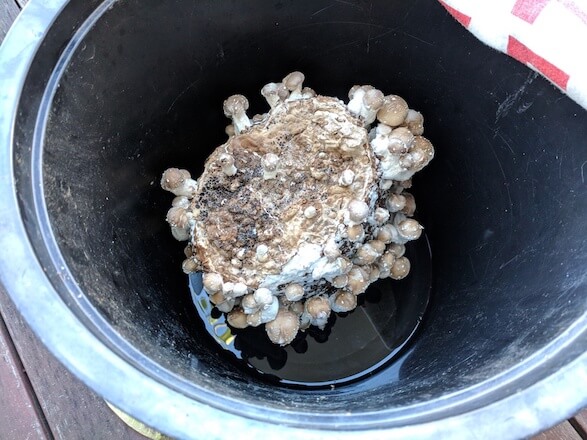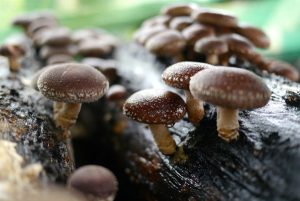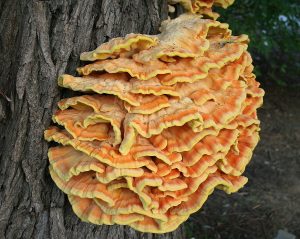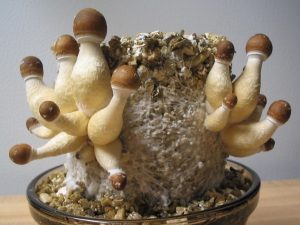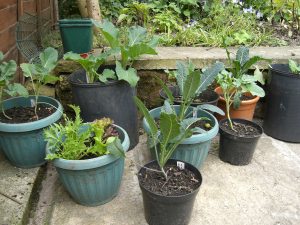We learn how to fruit shiitake mushroom blocks with Benedict Noel of The Mushroom Guide. It’s possible to grow shiitake mushrooms with very little equipment. If you’re a novice, this is the best place to start.
Catch up with Part 1 here.
The first thing you may be thinking is, what does “fruiting a shiitake block” mean? Let’s break this down. A shiitake block is an artificial log that shiitake mushrooms grow on, it’s usually composed of sawdust, bran and water. This mix of ingredients that the shiitake mushroom grows from is called the substrate. The mushroom is considered the fruiting body of fungi, whereas the part that colonises the block is called mycelium, it’s the vegetative part of fungi. Fruiting a block means that you put it in conditions that cause it to initiate the formation of mushrooms.
Shiitake mushrooms take a bit longer than most other types of gourmet mushrooms to fruit, typically after your sawdust substrate has been inoculated with mycelium it will be 2-3 months before you’ll be producing mushrooms. Other kinds of mushrooms have a much quicker turn around, vigorous strains of oyster mushrooms can fruit a week or two after the substrate being inoculated.
When to fruit
Once colonised with mycelium, your shiitake block will initially be white and then begin turning brown over the next 4-8 weeks. Ideally you should introduce your shiitake block to a fruiting environment when it’s at least 75% brown – about 8-12 weeks after it has been inoculated. As the block turns brown, it will also start to form little bumps all over it, this is often referred to as pop-corning.

Shiitake starting to popcorn. Credit: The Mushroom Guide
Ideal fruiting conditions
Many strains of shiitake can tolerate a wide range of temperatures. It’s possible to successfully fruit them when it’s snowing outside and also in temperatures above 30 degrees Celsius. I’ve had success fruiting shiitake in containers in my house during very hot summers where temperatures reach over 40° C outside. I find that shiitake do well in low temperatures, however, they grow a little slower and often produce less but larger mushrooms. In really hot temperatures the mushrooms grow quickly, but you need to be diligent about contaminants.
The main requirement for fruiting shiitake is they need a high humidity environment. This can be achieved using several low-tech methods described below. Unlike other popular gourmet mushrooms (e.g. oysters), shiitake are fairly tolerant of high CO2 environments, so you don’t need a lot of air-flow in conjunction with the high humidity.
Low tech fruiting
Preparing your block for fruiting
Approximately 1 week before you’re ready to eat your mushrooms, give the block a good whack on each side with your hand. You’re aiming to hit it hard, but without breaking it. About the same strength that you’d pat a large dog. Put your block in the fridge overnight.
In the morning take the block out of fridge and cut open the bag and put it aside to recycle. It’s best to open the block in the sink or the garden as there will be brown liquid (metabolites) that is likely to spill everywhere. Wash the block off under running water for about half a minute to get most of the brown liquid off. These steps simulate a shiitake-laden log falling in a forest as the seasons change.
Fruiting in a bucket
What you’ll need:
- A large bucket
- A brick
- A tea towel
Put a brick inside your bucket and fill the bucket with water so that the water level is a little below the top of the brick. Place your shiitake block on the brick so that it’s above the water and place a tea towel over the bucket. The tea towel helps to keep the humidity up. You can check on it periodically, it usually take 2-3 days for the first pins (baby mushrooms) to start forming.
Place your bucket inside the house or outside in the shade. If the tea towel gets rained on, it will fall in the bucket and ruin the humidity. If there’s too much sun, it will heat the block up and dry it out. I have an outdoor laundry that is a good location for doing this method. See it in action in the photo at the top of this post.
Pros: Simple, unlikely to have contamination issues
Cons: Harder to maintain high humidity, if there’s not enough light getting through, shiitake mushrooms can be paler (and will contain less vitamin D).
Fruiting in a plastic tub
What you’ll need:
- A large clear plastic storage container
- A hand-mister
A plastic storage container will be used as your fruiting vessel. If you don’t have one, you can get them fairly cheaply from hardware and office supply stores. The plastic tub should be as clean as possible before you put your shiitake block in it. Wash it out with hot water and detergent, or use a mix of 70% methylated spirits, 30% water in a spray bottle to sterilise it and then wipe it down with some clean paper towel.
Once the tub is clean, it’s simply a matter of placing your block in the tub and then opening it once per day to give it some air and a few quick squirts with a hand mister. You can take the lid off the container and use it as a fan to help get some get some oxygen in. I find that this method works better when the weather is warmer, as liquid is less likely to pool in the bottom of the container. The main problem you’ll have with this method is bacterial contamination. The block will continue to exude metabolites (brown liquid) that are susceptible to contamination, especially if the block is sitting directly in them. One way to avoid this is to do the same thing as the bucket method and place a brick in the container with water underneath. The liquid metabolites will disperse into the water and you can dump out this dirty water when you are ready to harvest.
Another method that I’ve developed that works quite well is to skewer the blocks on spikes in the container. This keeps the blocks off the bottom of the container and prevents them from sliding around or toppling over. It allows you to arrange the blocks to maximise fruiting space.

Raising shiitake reduces contamination. Credit: The Mushroom Guide
You can place the container inside or outside, as long as it’s not in direct sunlight. It’s fine to get a bit of morning sun, especially at the end of autumn, winter and the start of spring. I generally place my tubs along the south side of the house (I’m in the southern hemisphere) and they get plenty of indirect sunlight and the mushrooms turn out a nice brown colour.

Shiitake mushroom blocks with stakes removed. Credit: The Mushroom Guide
Pros: In my experience, this is the easiest way to get high yielding shiitake crops. The clear container also means that the mushrooms will get some sunlight, which means they’re browner in colour and contain more vitamin D.
Cons: Can contaminate more easily if tub isn’t clean, wrong time of year, or tub not opened periodically to allow in some fresh air.
Checking in on your mushrooms each day
For the first few days, open the fruiting container and give the block a couple of sprays with your hand mister. You want to wet each side of the block if starts to look like it’s drying out. In a few days you’ll see mushroom pins (baby mushrooms). Keep misting the blocks each day for a few more days and then stop misting when the mushroom pins start to look like proper mushrooms. If you mist the block as the mushrooms get larger, they tend to stay wet and have a reduced shelf life after harvesting. Within 7-10 days after placing your block in a container they should be ready for picking. The mushrooms should be doubling in size every day, once they stop growing it’s time to pick them!
Next time, we’ll cover how to harvest your mushrooms.
Based on an original post available here by Benedict Noel at The Mushroom Guide.
 About the author
About the author
The Mushroom Guide is written by Benedict Noel from Perth, Western Australia. He’s been hooked on mushroom growing since watching this TED talk in 2015 and has been building his knowledge and experience ever since. Since starting out, he’s helped run a couple of cultivation courses, given presentations at festivals and grown a wide variety of mushrooms, from oyster and shiitake to pioppino and chestnut.

